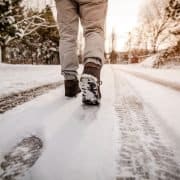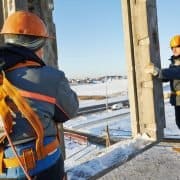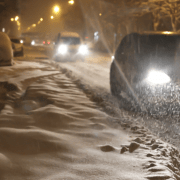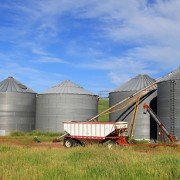Posts
Safety: Slips, trips and falls – winter safety tips
/in Agronomy, Grain Marketing, Safety/by Ryan MortierLet’s look at walking outside when it’s cold and snowy or icy.
Here are some winter safety tips to help prevent slips and falls:
- Plan ahead and give yourself sufficient time.
- When walking on steps, always use the hand railings and plant your feet firmly on each step.
- Bending your knees a little and taking slower and shorter steps increases traction and can greatly reduce your chances of falling.
- Streets and sidewalks that have been cleared of snow and ice should still be approached with caution. Look out for “black ice.” Dew, fog or water vapour can freeze on cold surfaces and form an extra-thin, nearly invisible layer of ice that can look like a wet spot on the pavement.
- Carrying heavy items can challenge your sense of balance. Try not to carry too much–you need to leave your hands and arms free to better balance yourself.
- Be prepared to fall and try to avoid using your arms to break your fall. If you fall backwards, make a conscious effort to tuck your chin so your head doesn’t strike the ground with a full force.
- When entering a building, remove as much snow and water from your boots as you can. Take notice that floors and stairs may be wet and slippery–walk carefully.
- Use special care when entering and exiting vehicles–use the vehicle for support.
Work safe. Farm safe. Home safe.™
™ is a registered trademark of Thompsons Limited.
Safety: Preparing for winter work
/in Agronomy, Grain Marketing, Safety, Weather/by Ryan MortierWorking outside in the winter can be a dirty job, but many of us have to do it.
Are you ready for winter work?
Here are some reminders about dressing for the weather and staying strong, healthy and safe:
- Two big concerns of working or simply spending time outdoors in cold weather are frostbite and hypothermia. Hypothermia is a potentially fatal condition caused by loss of body temperature, even in winter conditions people might not consider particularly nasty. Symptoms include fatigue, nausea, confusion, light-headedness and profuse sweating.
- Wear the right gloves for the work you are doing. Gloves should have enough insulation to keep you warm and prevent frostbite, but be thin enough so you can feel what you are doing if you are manipulating controls or tools. Gloves which are too thick can also make your hands and wrists work too hard trying to hold on to objects, causing repetitive strain injury.
- Dress in layers of light-weight clothing which keep you warmer than a single layer of heavy clothes. Remove layers as necessary to prevent overheating and perspiring which can lead to chills or hypothermia later. Protect your ears from frostbite as well by wearing a hat that will cover your ears, or use ear muffs.
- Keep your safety eyewear from fogging up in the cold. Investigate anti-fog coatings and wipes to see if these products are appropriate for your eyewear.
- Your shoes or boots should have adequate tread to prevent slips and falls on wet or icy surfaces. Slow down when walking across slippery surfaces and be especially careful on ladders, platforms and stairways.
- Get plenty of rest. Working in the cold and even traveling to and from work in the winter takes lots of energy. Cold weather can strain your heart, even if you aren’t overexerting yourself, so be sure to pace yourself when lifting heavy objects or shovelling snow.
Work safe. Farm safe. Home safe.™
Safety Insights – Winter Safety Tips
/in Safety/by Head OfficeThe winter season brings cold temperatures and often severe weather that create many hazards for individuals working in these conditions. Even if you work indoors, winter weather still poses many dangers for you such as driving into work in lousy weather or walking through an icy parking lot or yard to get to your building. It is essential to recognise and address the hazards winter brings with it.
Winter driving
One of the main issues winter poses in many parts of the country is poor driving conditions. The hazards created by winter weather make it hard for even the most experienced drivers to operate a vehicle safely.
Slips, trips, and falls are one of the leading causes of injuries and fatalities in the workplace. Snow, sleet, and ice significantly increase the chances for slip, trip, and fall incidents to occur.
Winter safety tips when driving
- Monitor weather for any incoming snow storms or icy conditions and plan your travel around those conditions. Do not put yourself in a situation where you are stuck on a roadside
- Do not drive in wintery conditions if possible. Eliminating driving eliminates your chances of being in an accident
- Be a defensive driver. Stay clear of other drivers and maintain a safe distance from the vehicle in front of you, in case you need to brake or turn to avoid an accident
- Slow down. Winter weather conditions necessitate having to reduce your speed. Reducing your driving speed will give you more time to react as well as help to avoid losing control of your vehicle
When walking on icy/ snowy surfaces
- Remove trip hazards before snow or ice conditions are present
- This eliminates someone tripping over a buried object after the snow or ice hits
- Shovel and salt parking lots and walkways before work begins in that area
- Have walkways addressed before workers get on site in the morning
- Take your time when walking across slippery surfaces
- Taking smaller steps lessens your chance of losing your balance
- Wear proper footwear for the weather condition. Wear shoes with solid tread on the soles
Soybean Storage and Conditioning
/in Agronomy, Grain Marketing, Weather/by Agronomy Team
Now that your crops are in the bin, it’s important to learn how to keep them conditioned and stored properly.
Throughout the winter months it’s important to monitor your soybean temperature, and to aerate your bins.
If you haven’t sold any beans then coring out your bin can be an option to remove some fines, and help stir the grain a bit.
It is important to make sure that soybeans are stored at a 14% moisture or lower. Don’t assume that because your beans went into the bin really dry, you don’t have to aerate. Those low moisture beans are still hot and need to have the field heat removed. Read more
To be leaders in the food and agribusiness sector through sustainability, integrity, relationships, employee engagement, profitability and innovation.





